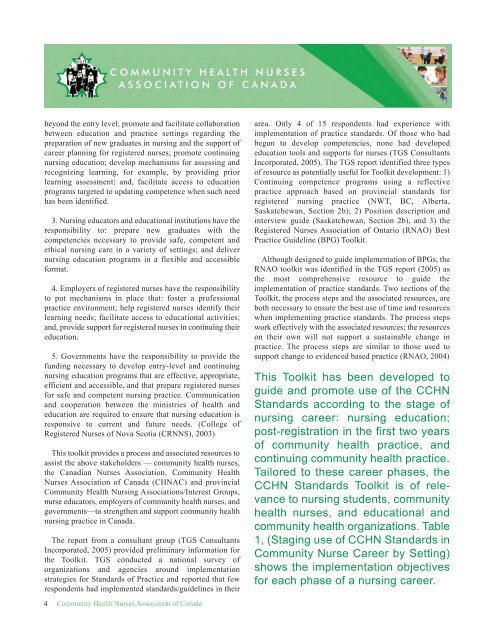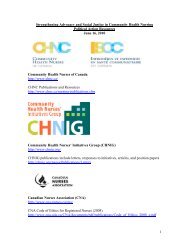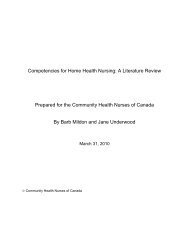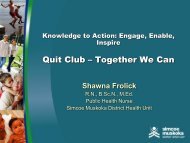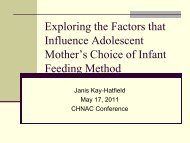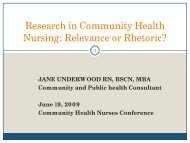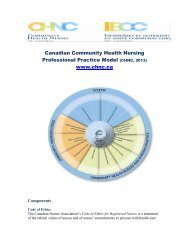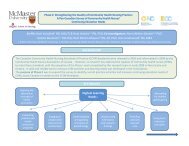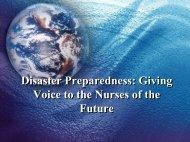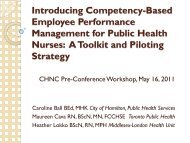Canadian Community Health Nursing Standards of Practice (CCHN ...
Canadian Community Health Nursing Standards of Practice (CCHN ...
Canadian Community Health Nursing Standards of Practice (CCHN ...
Create successful ePaper yourself
Turn your PDF publications into a flip-book with our unique Google optimized e-Paper software.
eyond the entry level; promote and facilitate collaboration<br />
between education and practice settings regarding the<br />
preparation <strong>of</strong> new graduates in nursing and the support <strong>of</strong><br />
career planning for registered nurses; promote continuing<br />
nursing education; develop mechanisms for assessing and<br />
recognizing learning, for example, by providing prior<br />
learning assessment; and, facilitate access to education<br />
programs targeted to updating competence when such need<br />
has been identified.<br />
3. <strong>Nursing</strong> educators and educational institutions have the<br />
responsibility to: prepare new graduates with the<br />
competencies necessary to provide safe, competent and<br />
ethical nursing care in a variety <strong>of</strong> settings; and deliver<br />
nursing education programs in a flexible and accessible<br />
format.<br />
4. Employers <strong>of</strong> registered nurses have the responsibility<br />
to put mechanisms in place that: foster a pr<strong>of</strong>essional<br />
practice environment; help registered nurses identify their<br />
learning needs; facilitate access to educational activities;<br />
and, provide support for registered nurses in continuing their<br />
education.<br />
5. Governments have the responsibility to provide the<br />
funding necessary to develop entry-level and continuing<br />
nursing education programs that are effective, appropriate,<br />
efficient and accessible, and that prepare registered nurses<br />
for safe and competent nursing practice. Communication<br />
and cooperation between the ministries <strong>of</strong> health and<br />
education are required to ensure that nursing education is<br />
responsive to current and future needs. (College <strong>of</strong><br />
Registered Nurses <strong>of</strong> Nova Scotia (CRNNS), 2003)<br />
This toolkit provides a process and associated resources to<br />
assist the above stakeholders — community health nurses,<br />
the <strong>Canadian</strong> Nurses Association, <strong>Community</strong> <strong>Health</strong><br />
Nurses Association <strong>of</strong> Canada (CHNAC) and provincial<br />
<strong>Community</strong> <strong>Health</strong> <strong>Nursing</strong> Associations/Interest Groups,<br />
nurse educators, employers <strong>of</strong> community health nurses, and<br />
governments—to strengthen and support community health<br />
nursing practice in Canada.<br />
The report from a consultant group (TGS Consultants<br />
Incorporated, 2005) provided preliminary information for<br />
the Toolkit. TGS conducted a national survey <strong>of</strong><br />
organizations and agencies around implementation<br />
strategies for <strong>Standards</strong> <strong>of</strong> <strong>Practice</strong> and reported that few<br />
respondents had implemented standards/guidelines in their<br />
area. Only 4 <strong>of</strong> 15 respondents had experience with<br />
implementation <strong>of</strong> practice standards. Of those who had<br />
begun to develop competencies, none had developed<br />
education tools and supports for nurses (TGS Consultants<br />
Incorporated, 2005). The TGS report identified three types<br />
<strong>of</strong> resource as potentially useful for Toolkit development: 1)<br />
Continuing competence programs using a reflective<br />
practice approach based on provincial standards for<br />
registered nursing practice (NWT, BC, Alberta,<br />
Saskatchewan, Section 2b); 2) Position description and<br />
interview guide (Saskatchewan, Section 2b), and 3) the<br />
Registered Nurses Association <strong>of</strong> Ontario (RNAO) Best<br />
<strong>Practice</strong> Guideline (BPG) Toolkit.<br />
Although designed to guide implementation <strong>of</strong> BPGs, the<br />
RNAO toolkit was identified in the TGS report (2005) as<br />
the most comprehensive resource to guide the<br />
implementation <strong>of</strong> practice standards. Two sections <strong>of</strong> the<br />
Toolkit, the process steps and the associated resources, are<br />
both necessary to ensure the best use <strong>of</strong> time and resources<br />
when implementing practice standards. The process steps<br />
work effectively with the associated resources; the resources<br />
on their own will not support a sustainable change in<br />
practice. The process steps are similar to those used to<br />
support change to evidenced based practice (RNAO, 2004)<br />
This Toolkit has been developed to<br />
guide and promote use <strong>of</strong> the <strong>CCHN</strong><br />
<strong>Standards</strong> according to the stage <strong>of</strong><br />
nursing career: nursing education;<br />
post-registration in the first two years<br />
<strong>of</strong> community health practice, and<br />
continuing community health practice.<br />
Tailored to these career phases, the<br />
<strong>CCHN</strong> <strong>Standards</strong> Toolkit is <strong>of</strong> relevance<br />
to nursing students, community<br />
health nurses, and educational and<br />
community health organizations. Table<br />
1, (Staging use <strong>of</strong> <strong>CCHN</strong> <strong>Standards</strong> in<br />
<strong>Community</strong> Nurse Career by Setting)<br />
shows the implementation objectives<br />
for each phase <strong>of</strong> a nursing career.<br />
4 <strong>Community</strong> <strong>Health</strong> Nurses Association <strong>of</strong> Canada


